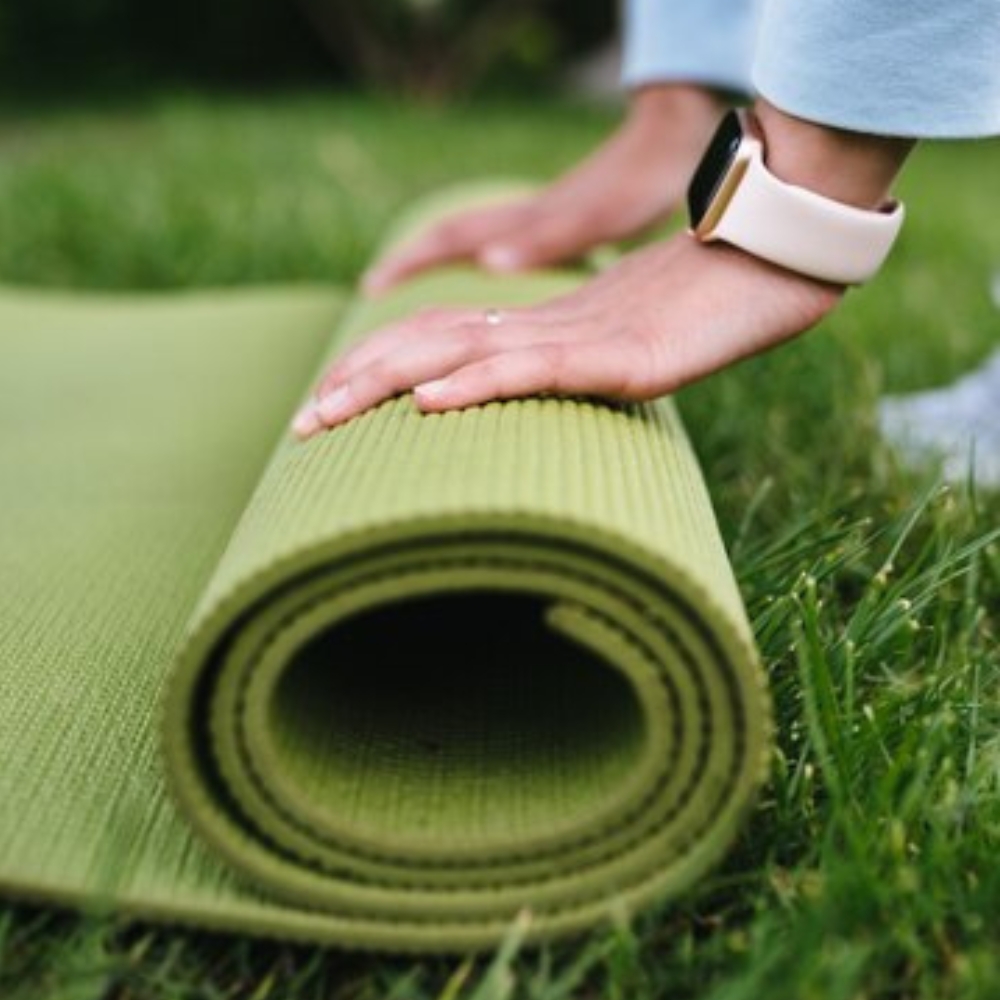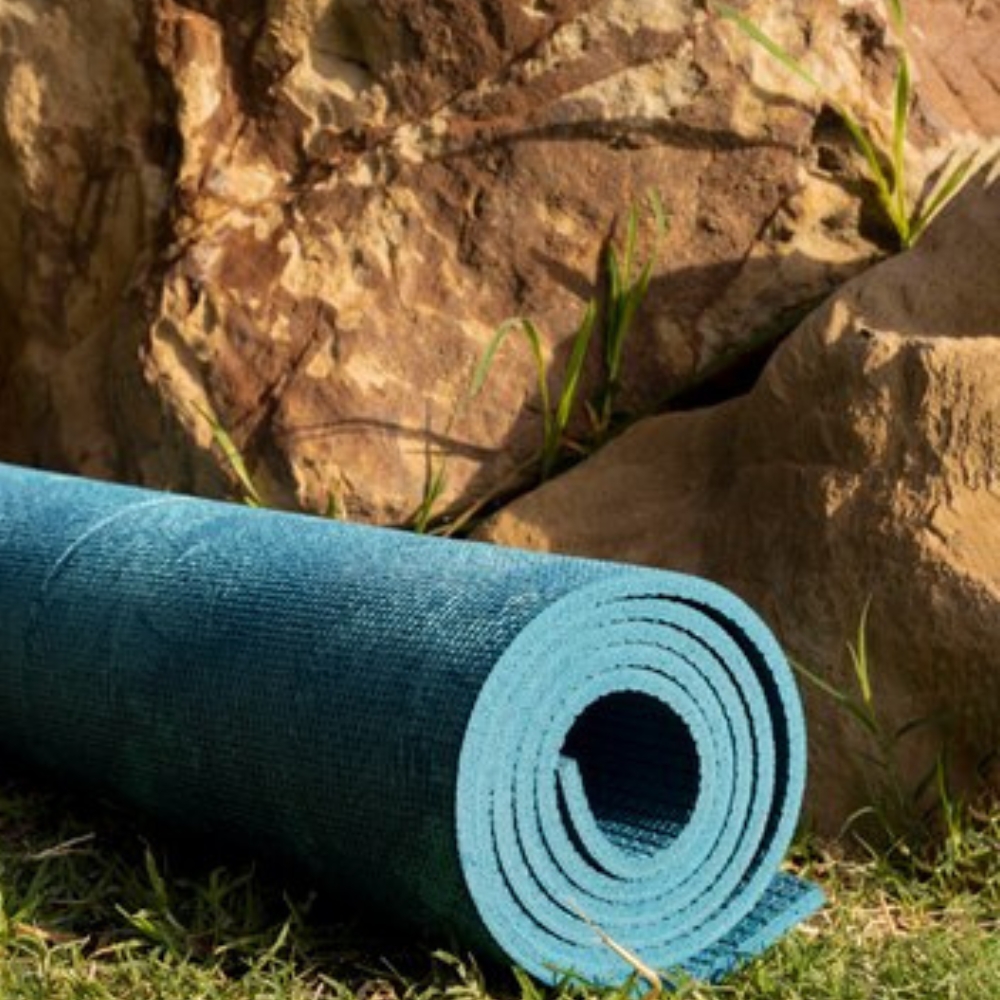
Is your yoga mat bad for the environment? This question may catch many yoga enthusiasts off guard, as they often see their practice as a fusion of mind, body, and spirit, closely connected with a reverence for nature. But have you considered the environmental impact of your yoga mat?
Manufacturers use polyvinyl chloride (PVC) to make most conventional yoga mats, a plastic known for its significant environmental hazards from production to disposal. These PVC yoga mats emit harmful toxins throughout their lifecycle, adding to pollution and health risks.
The world of eco-friendly yoga mats is evolving with innovative alternatives that promise sustainability without compromising on quality. Are they really better for the planet? Dive into the details with us, as we explore the environmental footprint of yoga mats and unveil some of the most sustainable options available, guided by insights from renowned environmental experts. Also, if perhaps you need to choose waterproof fitness trackers, we have prepared for you a review of best waterproof fitness trackers, you can see it here
Table of Contents
Yoga Mats and Their Impact on the Environment.
Yoga mats can be bad for the environment due to several factors:
Material Used
Traditional yoga mats, often made from PVC (polyvinyl chloride), represent a poor choice due to their environmental impact. This plastic material does not biodegrade, significantly increasing landfill waste. Additionally, producing PVC involves releasing toxic chemicals, and the material continues to emit harmful compounds throughout its life, posing risks to human health and the environment.
Non-Biodegradable and Non-Recyclable
Many yoga mats are non-biodegradable and non-recyclable. This means they can take hundreds of years to decompose in landfills, leading to long-term environmental pollution.
Chemical Additives
Some yoga mats contain chemical additives for flexibility, durability, or to make them non-slip. These additives can be harmful to both the environment and human health. They might release volatile organic compounds (VOCs) that contribute to air pollution and can be toxic if ingested or inhaled.
Energy-Intensive Manufacturing Process
The production of yoga mats, particularly those made from synthetic materials, can be energy-intensive, contributing to carbon emissions and environmental degradation.
Transportation Impact
The carbon footprint of yoga mats also includes transportation from the place of manufacturing to the consumer. This transportation often involves long distances, contributing to greenhouse gas emissions.
Overuse of Resources
The production of some materials used in yoga mats, like rubber, can lead to overuse of natural resources and potential harm to ecosystems where these materials are harvested.
End-of-Life Disposal Issues
Disposal of yoga mats poses environmental challenges. Since many are not recyclable, they end up in landfills or are incinerated, which can release harmful pollutants.
To mitigate these environmental impacts, many people are turning to eco-friendly yoga mats made from sustainable, biodegradable materials like natural rubber, jute, or organic cotton. These materials generally have a lower environmental footprint and are often produced with more sustainable manufacturing processes. For those committed to both their practice and the planet, exploring the best eco-friendly yoga mat options can be a significant step towards a more sustainable lifestyle. These alternatives not only lessen environmental harm but also align with the values of mindfulness and respect for nature that yoga promotes.
Do All Yoga Mats Negatively Impact the Environment?

Yoga mats, like many products, can have environmental impacts depending on the materials used and the manufacturing processes. Here’s a breakdown of different types of yoga mats and their environmental considerations:
1. PVC Mats
Traditional yoga mats are often made from polyvinyl chloride (PVC), which is a plastic. PVC production can release toxic chemicals, and the mats are not biodegradable. They are considered to be the least environmentally friendly option.
2. TPE Mats
Thermoplastic elastomer (TPE) mats are a more eco-friendly alternative to PVC. TPE is a more biodegradable material and typically does not contain harmful chemicals like phthalates or BPA. However, the biodegradability and environmental impact can vary based on the specific type of TPE and the manufacturing process.
3. Natural Rubber Mats
Made from rubber trees, these mats are biodegradable and don’t contain PVC, making them a more environmentally friendly choice. However, natural rubber production can have impacts on ecosystems if not sustainably managed.
4. Cork Mats
Cork, known for its renewable and biodegradable qualities, serves as an ideal material for non-toxic yoga mats. These mats are produced without the need for harmful chemicals, making them a top choice for eco-friendly yoga practices.
5. Jute and Cotton Mats
These mats are made from natural fibers and are biodegradable. They are environmentally friendly options, but may not offer the same durability or cushioning as some other materials.
6. Recycled and Upcycled Mats
Some companies produce mats from recycled or upcycled materials like recycled wetsuits or other rubber products. These are environmentally friendly options as they help reduce waste.
7. Eco-Friendly Certifications
Look for certifications like OEKO-TEX or GreenGuard, which indicate that a product is free from harmful chemicals and meets certain environmental standards.
The Future of Yoga Mats – Innovations and Trends.
The future of yoga mats is being shaped by innovations and trends that focus on sustainability, technology integration, and enhanced user experience. Here’s an overview of what we might expect in the coming years:
Eco-Friendly Materials
As environmental concerns continue to grow, there’s a strong trend towards more sustainable materials. Future yoga mats might utilize advanced biodegradable materials or upcycled components, reducing their environmental impact. Innovations in materials science could lead to mats that are both eco-friendly and highly durable.
Improved Sustainability Practices
Beyond the materials themselves, the entire lifecycle of yoga mats will likely become more sustainable. This includes more energy-efficient manufacturing processes, reduced packaging waste, and programs for recycling or upcycling old mats.
Smart Technology Integration
With the rise of smart fitness equipment, yoga mats could incorporate technology for enhanced practice. This might include built-in sensors to provide feedback on posture and alignment, or integration with fitness apps to track progress. Some mats might even feature interactive surfaces to guide yoga routines.
Customization and Personalization
Advances in manufacturing technology could allow for greater customization of yoga mats. This could range from selecting the exact thickness and firmness to personalized designs or even mats that are shaped to the individual’s body for optimal support.
Hybrid Mats for Multiple Activities
As people increasingly seek versatile fitness solutions, we might see the development of hybrid mats suitable for various activities like yoga, Pilates, and general fitness exercises. These mats would be designed to provide the optimal surface for a range of activities.
Health and Wellness Features
Future yoga mats could incorporate features that enhance overall wellness. This could include materials with antimicrobial properties to improve hygiene or surfaces designed to provide therapeutic benefits, such as acupressure points.
Accessibility
There will likely be a greater focus on making yoga mats accessible for all body types and abilities. This includes designing mats for different physical needs and ensuring that products are available and affordable to a wide range of people.
Artistic and Designer Collaborations
Yoga mats might become a medium for artistic expression, with collaborations between yoga brands and artists or designers. This would cater to a market that values aesthetics alongside functionality.
Augmented Reality (AR) and Virtual Reality (VR) Compatibility
With the rise of AR and VR in fitness, yoga mats could be designed to work seamlessly with these technologies, providing immersive experiences for home yoga practices.
These innovations will not only enhance the practice of yoga but also contribute to broader environmental and social wellness goals.
How to Choose an Environmentally Friendly Yoga Mat?
Choosing an environmentally friendly yoga mat involves considering various factors that contribute to its ecological impact. Here’s a guide to help you make a more sustainable choice:
1. Material
Look for mats made from natural, renewable, or recycled materials. Options include natural rubber, organic cotton, jute, cork, and TPE (Thermoplastic Elastomer). Avoid PVC (polyvinyl chloride) mats, as PVC is a non-renewable, toxic plastic that is not biodegradable.
2. Sustainability of Production
Investigate how the mat is produced. Opt for mats manufactured using sustainable practices, like reduced energy consumption, minimal waste, and no harmful emissions. Companies that engage in responsible manufacturing practices often share this information openly.
3. Toxicity
Choose mats that are free from toxic chemicals like phthalates, BPA, and heavy metals. Certifications like OEKO-TEX, GreenGuard, or EcoLabel can be helpful indicators of a non-toxic mat.
4. Biodegradability
Consider the end-of-life of the mat. Biodegradable mats made from natural materials can decompose and reduce landfill waste. Even if a mat is made from synthetic materials, check if it’s recyclable.
5. Durability
A durable yoga mat, although not immediately associated with environmental friendliness, actually contributes to it by lasting longer. This longevity reduces the need to replace the mat frequently, which in turn decreases its environmental impact over time.
6. Brand Ethics
Research the brand’s overall commitment to sustainability. Some companies go beyond just creating eco-friendly products; they may engage in practices like carbon offsetting, ethical labor practices, and supporting environmental causes.
7. Transport and Packaging
Consider the carbon footprint involved in transporting the mat. Choosing locally produced mats can reduce this impact. Also, look for minimal and recyclable or compostable packaging.
8. End-of-Life Options
Investigate if the company offers a recycling program for their mats or if the mat can be repurposed or composted at the end of its life.
By considering these factors, you can choose a yoga mat that aligns with your environmental values without compromising on quality and performance.

Conclusion
The materials and manufacturing process of a yoga mat significantly determine its environmental impact. People often consider traditional PVC mats harmful because they don’t biodegrade and release dangerous chemicals during production and disposal. However, the emergence of more eco-friendly options, such as mats made from natural rubber, cork, TPE, or recycled materials, represents a positive change. These recycled yoga mats aim to reduce environmental damage, featuring sustainable, non-toxic, and often biodegradable properties. Choosing a yoga mat made of such eco-conscious materials and produced sustainably can greatly reduce your ecological footprint, contributing to a more sustainable and healthier planet.

I’m Heorhii Rysak, a go-to sports enthusiast and blogger. My fascination with sports began in my childhood with karate, setting the foundation for my love of physical fitness. Over the years, I’ve delved into various disciplines, including martial arts and CrossFit, and developed a passion for tennis. I bring a wealth of practical experience to my blog, where I share equipment reviews, workout plans, and fitness advice. My goal is simple: to inspire and assist you in your journey toward better health and performance.